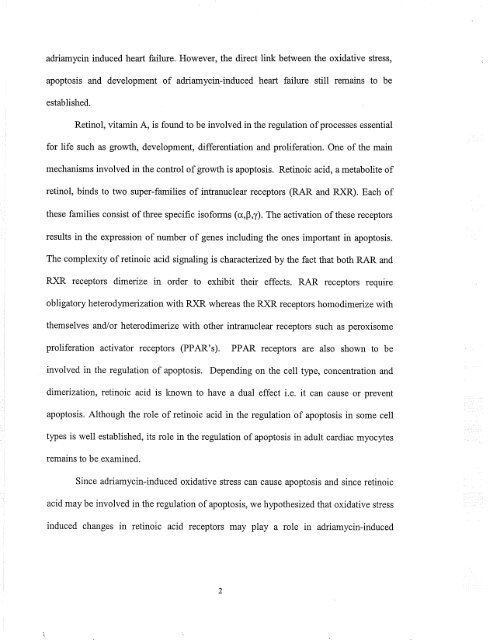il\VOLVEMENT OF RETII\OIC ACID II{ - MSpace at the University of ...
il\VOLVEMENT OF RETII\OIC ACID II{ - MSpace at the University of ...
il\VOLVEMENT OF RETII\OIC ACID II{ - MSpace at the University of ...
Create successful ePaper yourself
Turn your PDF publications into a flip-book with our unique Google optimized e-Paper software.
adriamycin induced heart failure. However, <strong>the</strong> direct link between <strong>the</strong> oxid<strong>at</strong>ive stress,<br />
apoptosis and development <strong>of</strong> adriamycin-induced heart failure still remains to be<br />
established.<br />
Retinol, vitamin A, is found to be involved in <strong>the</strong> regul<strong>at</strong>ion <strong>of</strong> processes essential<br />
for life such as growth, development, differenti<strong>at</strong>ion and prolifer<strong>at</strong>ion. One <strong>of</strong> <strong>the</strong> main<br />
mechanisms involved in <strong>the</strong> control <strong>of</strong> growth is apoptosis. Retinoic acid, a metabolite <strong>of</strong><br />
retinol, binds to two super-families <strong>of</strong> intranuclear receptors (RAR and RXR). Each <strong>of</strong><br />
<strong>the</strong>se families consist <strong>of</strong> three specific is<strong>of</strong>orms (o,F,y).The activ<strong>at</strong>ion <strong>of</strong> <strong>the</strong>se receptors<br />
results in <strong>the</strong> expression <strong>of</strong> number <strong>of</strong> genes including <strong>the</strong> ones important in apoptosis.<br />
The complexity <strong>of</strong> retinoic acid signaling is charactenzed by <strong>the</strong> fact th<strong>at</strong> both RAR and<br />
RXR receptors dimenze in order to exhibit <strong>the</strong>ir effects. RAR receptors require<br />
oblig<strong>at</strong>ory heterodymeriz<strong>at</strong>ion with RXR whereas <strong>the</strong> RXR receptors homodimerize with<br />
<strong>the</strong>mselves and/or heterodimerize with o<strong>the</strong>r intranuclear receptors such as peroxisome<br />
prolifer<strong>at</strong>ion activ<strong>at</strong>or receptors (PPAR's). PPAR receptors are also shown to be<br />
involved in <strong>the</strong> regul<strong>at</strong>ion <strong>of</strong> apoptosis. Depending on <strong>the</strong> cell type, concentr<strong>at</strong>ion and<br />
dimeriz<strong>at</strong>ion, retinoic acid is known to have a dual effect i.e. it can cause or prevent<br />
apoptosis. Although <strong>the</strong> role <strong>of</strong> retinoic acid in <strong>the</strong> regul<strong>at</strong>ion <strong>of</strong> apoptosis in some cell<br />
types is well established, its role in <strong>the</strong> regul<strong>at</strong>ion <strong>of</strong> apoptosis in adult cardiac myocytes<br />
remains to be examined.<br />
Since adriamycin-induced oxid<strong>at</strong>ive stress can cause apoptosis and since retinoic<br />
acid may be involved in <strong>the</strong> regul<strong>at</strong>ion <strong>of</strong> apoptosis, we hypo<strong>the</strong>sized th<strong>at</strong> oxid<strong>at</strong>ive stress<br />
induced changes in retinoic acid receptors may play a role in adriamycin-induced







![an unusual bacterial isolate from in partial fulf]lment for the ... - MSpace](https://img.yumpu.com/21942008/1/190x245/an-unusual-bacterial-isolate-from-in-partial-fulflment-for-the-mspace.jpg?quality=85)





![in partial fulfil]ment of the - MSpace - University of Manitoba](https://img.yumpu.com/21941988/1/190x245/in-partial-fulfilment-of-the-mspace-university-of-manitoba.jpg?quality=85)


